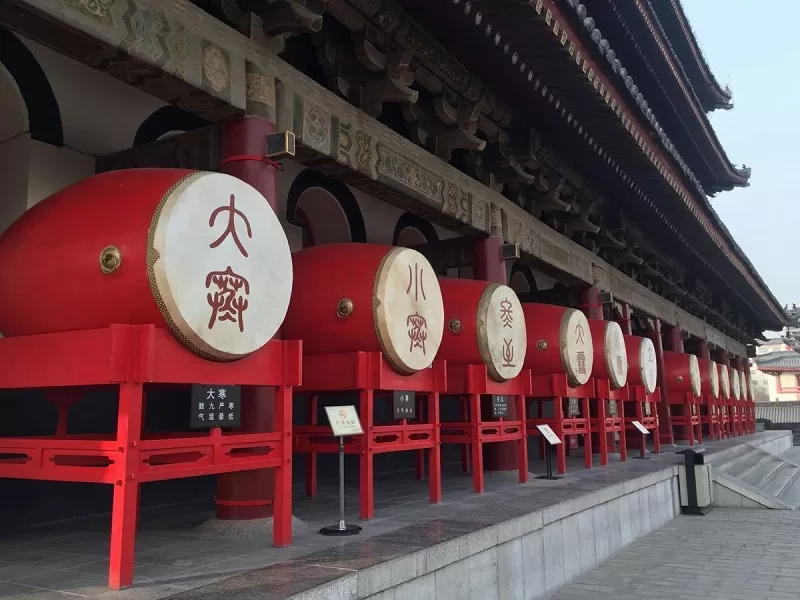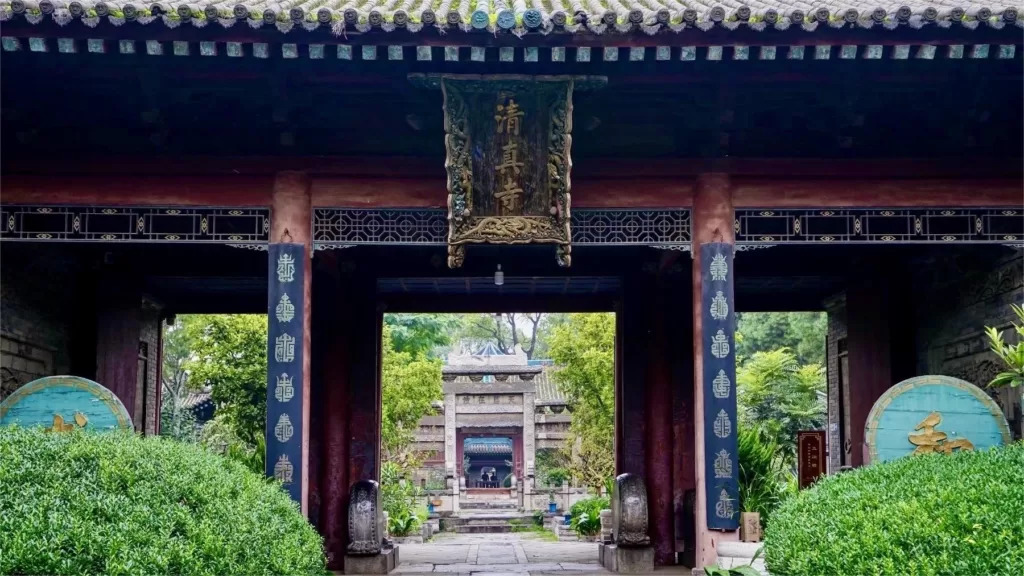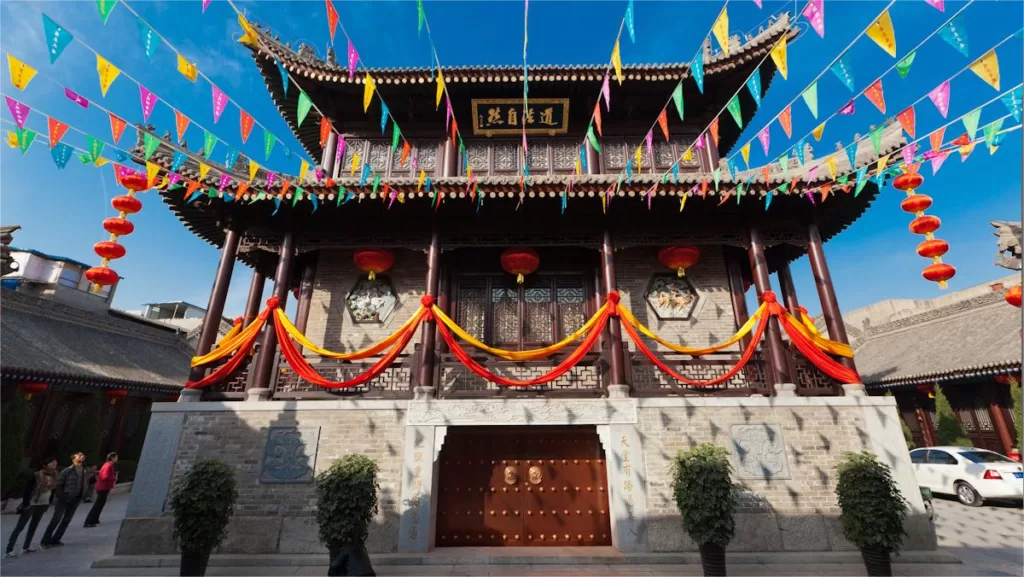The Drum Tower (鼓楼), located in the heart of Xi’an, is a prominent historical monument situated approximately 200 meters northwest of the Bell Tower. This impressive structure, constructed in 1380, stands as one of the largest and best-preserved drum towers among its ancient counterparts in China.
Originally, the Drum Tower featured a colossal drum on its upper level, which was used to mark the passing of time with daily drumbeats. The tower is built upon a square-shaped base and boasts a sturdy brick and wood structure. Its roof exhibits the traditional double-eaved design. With a towering height of 36 meters and occupying an area of 1377 square meters, the tower offers a spiraling staircase that allows visitors to ascend.
The exterior is adorned with deep green glazed tiles, while the interior is adorned with intricate gilded murals, decorative beams, and ornate carvings. At the top, a golden roof ornament adds to the tower’s grandeur, making it a symbol of Xi’an’s rich heritage and a must-see architectural marvel.
Table of Contents
- Basic Information
- Location and Transportation
- Highlights of the Drum Tower
- Vlog about Xi’an Drum Tower
- History of Xi’an Drum Tower
- Useful Tips Summarized from Reviews
- Attractions near the Drum Tower
Basic Information
| Website | http://www.zglxa.com/ |
| Estimated Length of Tour | 0.5 – 1 hour |
| Opening Hours | 8.30 – 21.30; Last entry: 21.00 (1st April – 10th October); 8.30 – 18.00; Last entry: 17.30 (11th October – 31st March the next year) |
| Ticket Price | Adult: 30 yuan Children under 6 years old or below 1.2 meters: free Senior citizens above 65 years old: free |
| Combination Ticket | Ticket for the Bell Tower and Drum Tower: 50 yuan |
Location and Transportation
The tower is surrounded by a bustling commercial district, where visitors can find a variety of shops, restaurants, and markets selling traditional handicrafts, souvenirs, and local delicacies. Its specific address is 74 Beiyuanmen Street, Lianhu District, Xi’an, Shaanxi.
Bus: Take bus No. 15, 32, 43, 45, 201, 215, 218, 221, 222, 251, 252, 286, 300, 604, 611, 612, 618, or 622, get off at Zhonglouxi Stop (West of the Bell Tower), and walk 100 meters to the northwest.
Take bus No. 4, 12, 37, 229, 235, 600, or 606, get off at Zhongloubei Stop (North of the Bell Tower), and walk about 150 meters to the southwest.
Subway: Take subway line 2 or 6, get off at Zhonglou Station (Bell Tower), get out from exit 1, and walk about 100 meters to the west to reach the Drum Tower.
Highlights of the Drum Tower
Architectural Style of the Tower

The Drum Tower showcases a distinctive architectural style, characterized by a wooden framework in the bracket-set style. It consists of two stories and features a triple-eaved roof design. The construction techniques of the Drum Tower draw inspiration from Tang Dynasty aesthetics and adhere to the architectural principles of the Song Dynasty, yet they also incorporate innovative elements. Notably, the entire structure is assembled without the use of a single iron nail. The eaves and the flat base employ the principle of bracket sets (dougong), showcasing the tower’s elegant and robust appearance, while embodying a rich national character.
The Drum of the Tower

In 1996, as part of an effort to revive the tradition of “Morning Bell and Evening Drum,” Xi’an decided to recreate the Giant Drum housed in the Drum Tower. This reconstructed colossal drum stands at 1.8 meters in height, boasts a drumhead diameter of 2.83 meters, and weighs 1.5 tons. It is crafted from a single piece of high-quality cowhide. On its surface, 1996 brass nails symbolize the year of its creation, and four copper rings represent the year 2000, signifying progress and the entry into the 21st century.
The Performance

The performance in the Drum Tower of Xi’an is a cultural experience that showcases traditional Chinese music and dance. The performance features skilled musicians and dancers dressed in colorful costumes, playing a variety of traditional instruments and performing intricate choreography. The highlight of the performance is the drumming, where skilled performers play the large drum located in the tower’s uppermost level. Visitors can watch the performance from a platform below the drum tower or from a nearby theater.
Performantice starts at 9.30; 10.15; 11.00; 11.45; 14.00; 14.45; 15.30; 16.20 every day and lasts about 5 minutes.
The Plaques

Beneath the third eave of the Drum Tower, two prominent plaques adorn its walls. To the south, there is a plaque that reads “文武盛地” (Flourishing Place of Both Civil and Military Achievements), which was inscribed in 1590. On the north side, you’ll find the plaque “声闻于天” (Heard in Heaven), created in 1740. These plaques are impressive, measuring 8 meters in length and 3.6 meters in width, featuring golden characters against a blue background on wooden boards. Unfortunately, during the Cultural Revolution, both plaques suffered damage, but they were thankfully restored to their original glory in 2005.
Vlog about Xi’an Drum Tower
History of Xi’an Drum Tower
The Drum Tower of Xi’an, a significant historical landmark, was originally constructed in the 13th year of the Hongwu reign during the Ming Dynasty (1380), predating the Bell Tower by four years. The name “Drum Tower” originates from the enormous drum that once resided within the tower, which was used to mark the hours of the day. Positioned on the bustling Beiyuanmen Street, the Drum Tower stands only 200 meters away from the Bell Tower, creating a symbolic and architectural pair in the heart of Xi’an.
The construction of the Drum Tower was overseen by Geng Bingwen, the Marquis of Changxing, and Wang Zongzhou, the governor of Xi’an at the time. It is said that the foundation of the tower was laid during a light rain, marking a solemn and auspicious beginning to the project. The tower has undergone several restorations over the centuries, notably in the 38th year of Emperor Kangxi’s reign (1699) and the 4th year of Emperor Qianlong’s reign (1740) during the Qing Dynasty.
A significant restoration effort in 1740 was prompted by a bountiful harvest in Shaanxi Province, which brought prosperity and peace to the region. Inspired by ancient traditions of celebrating times of abundance by constructing grand buildings, the local magistrate, Wang Rui, took charge of the renovation. This restoration underscored the Drum Tower’s importance as both a functional timekeeper and a symbol of civic pride.
During the Ming and Qing Dynasties, the Drum Tower was strategically located in the southwestern part of Xi’an’s city center, where the sound of its drum could be heard across the entire city. Surrounding the tower were government offices and residences, all of which relied on the drum’s sound for daily life and official activities. The Drum Tower’s role in the city’s rhythm was immortalized by the scholar Li Yunkuan, who inscribed the words “The Sound Reaches the Heavens” on a plaque, highlighting the tower’s significance.
Today, the Drum Tower stands as one of the main architectural symbols of Ming and Qing-era Xi’an. Visitors can climb the tower and enjoy panoramic views of the ancient city, experiencing firsthand the historical and cultural legacy that the Drum Tower represents.
Useful Tips Summarized from Reviews
Timing: The best time to visit the Drum Tower is during the day, preferably in the morning or early afternoon when there are fewer crowds. Avoid visiting during peak tourist seasons, such as Chinese New Year or Golden Week, as the tower can get extremely crowded.
Cultural Performance: Be sure to check the schedule for cultural performances, which typically take place several times a day. Watching a performance is a great way to experience traditional Chinese music and dance.
Photography: The Drum Tower offers excellent photo opportunities, so bring your camera or smartphone to capture the stunning views and performances. However, be respectful of performers and other visitors when taking photos.
Cultural exhibits: Take the time to visit the exhibits and displays that explain the tower’s history and cultural significance. This will enhance your understanding of the tower and its role in Xi’an’s history.






